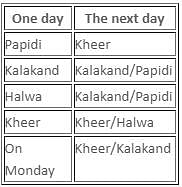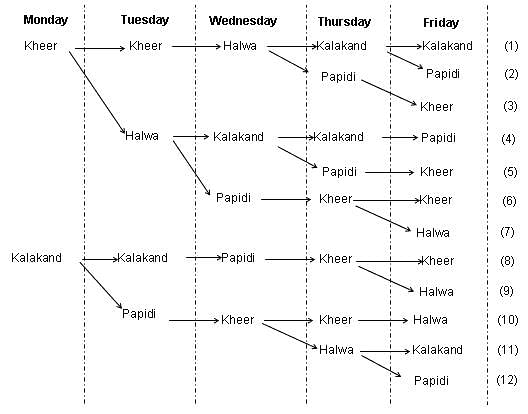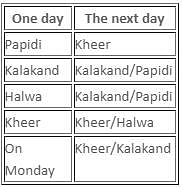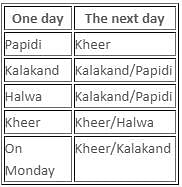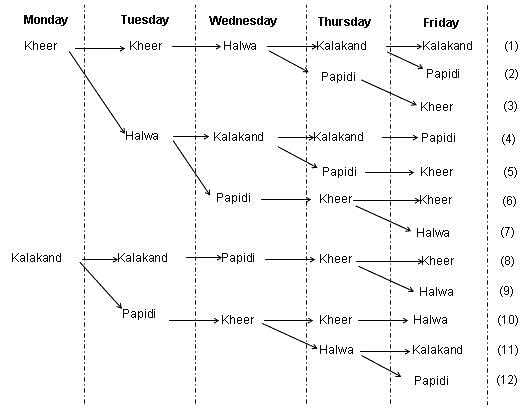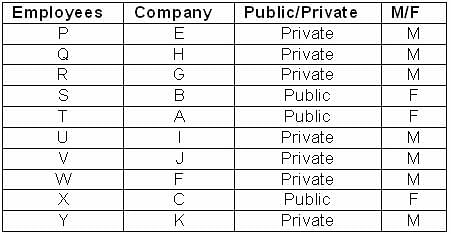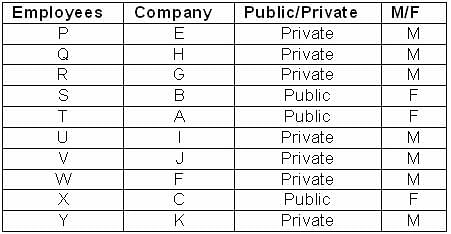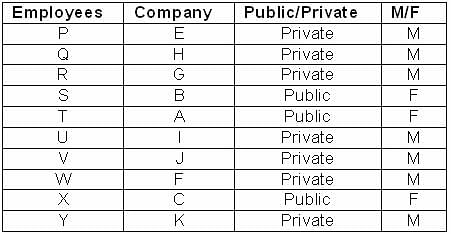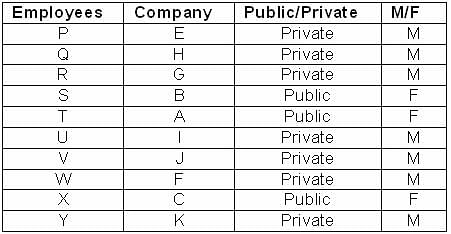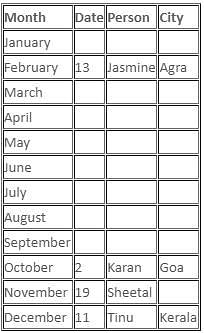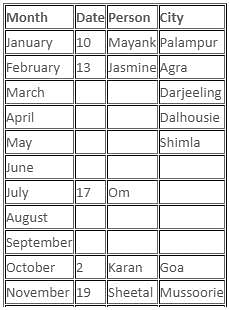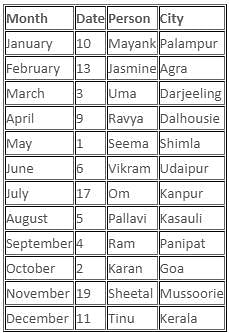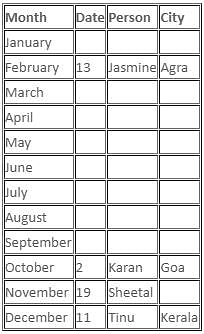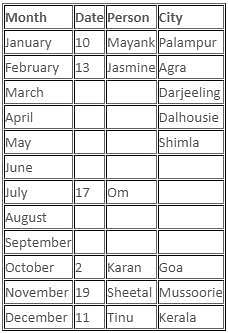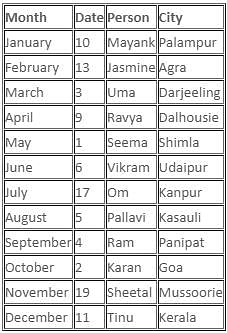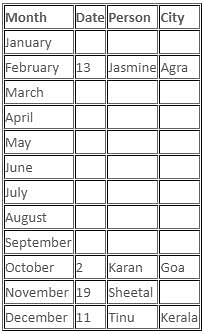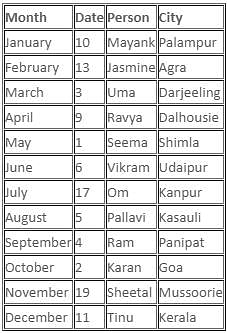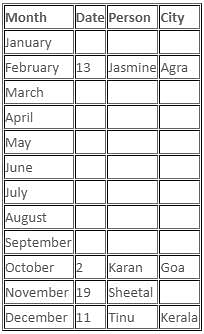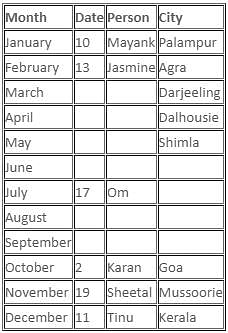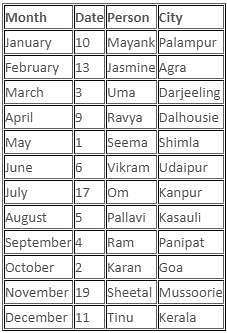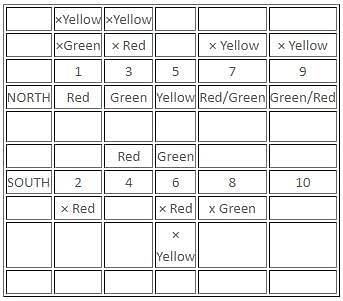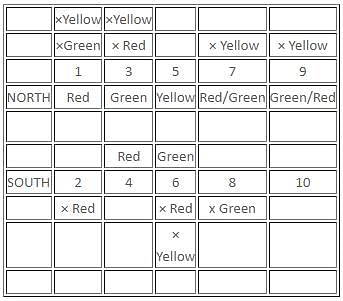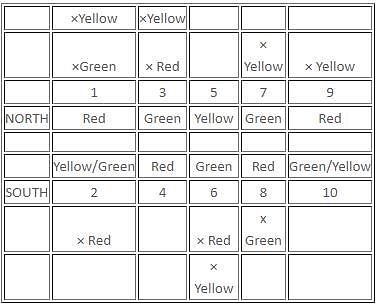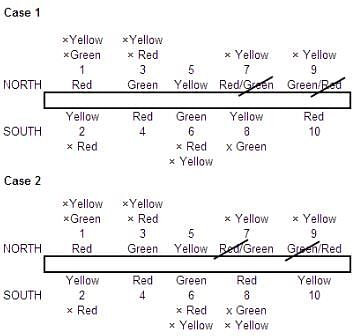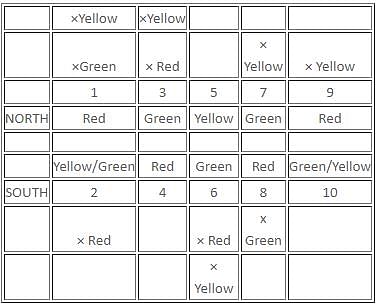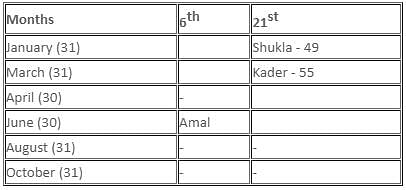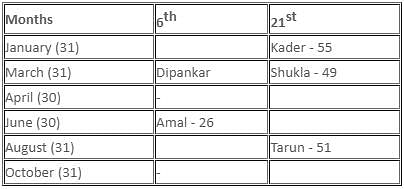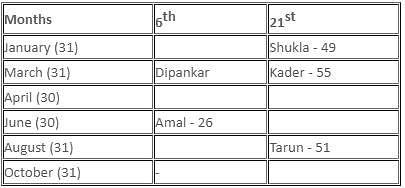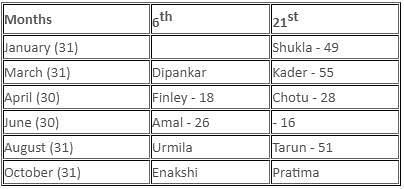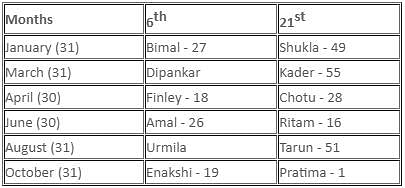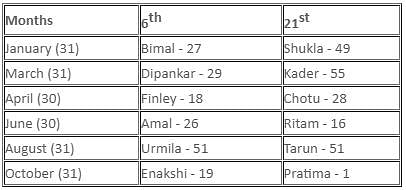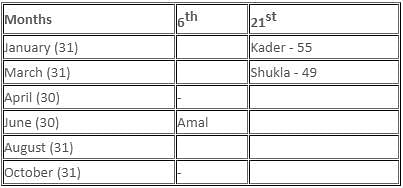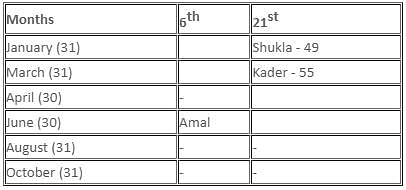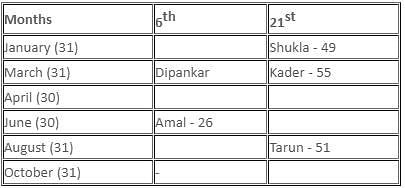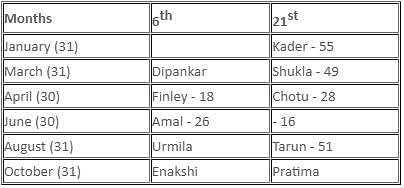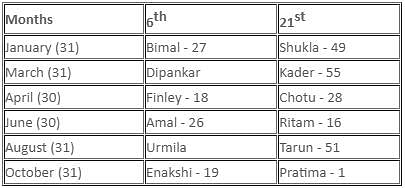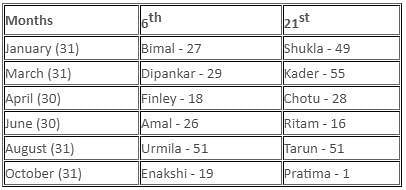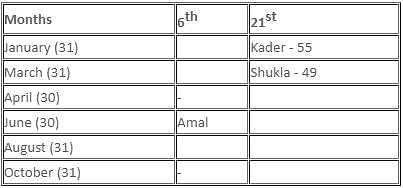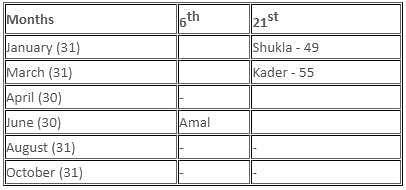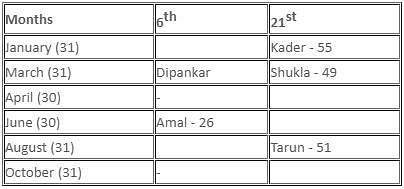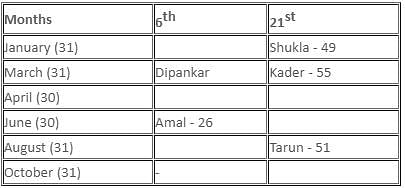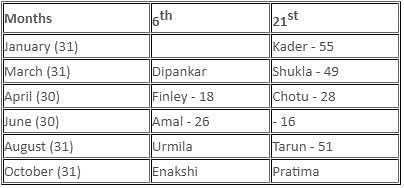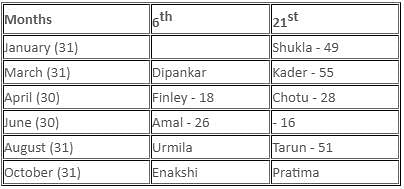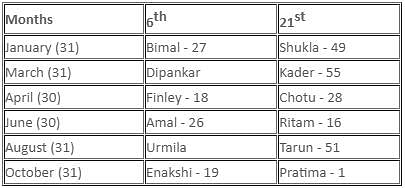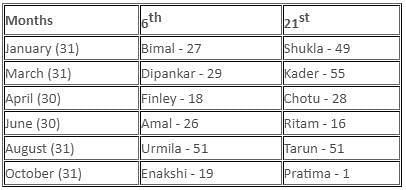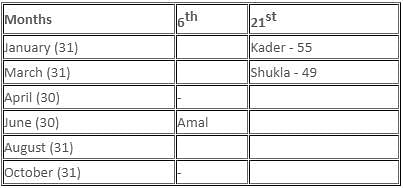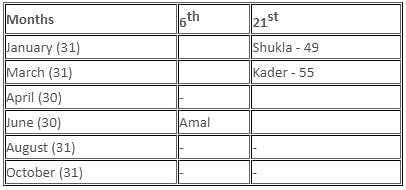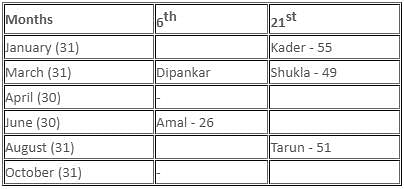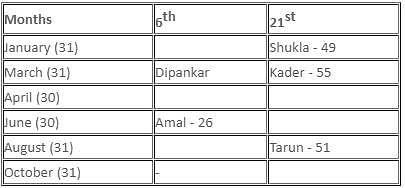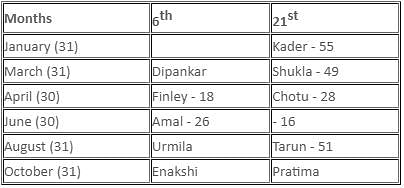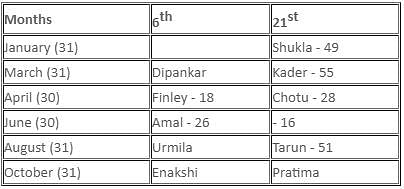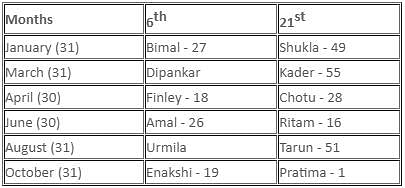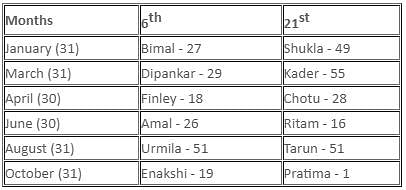Test Level 3: Logical Games - CAT MCQ
20 Questions MCQ Test Level-wise Tests for CAT - Test Level 3: Logical Games
Directions: Answer the questions based on the information that follows:
Vamsi gets his lunch from Hotel Annapurna, from Monday to Friday every week. He will get any one of these desserts daily - Kheer, Kalakand, Papidi or Halwa - along with his lunch. Also,
- He does not get the same dessert for more than two consecutive days.
- If he gets Papidi one day, he will get Kheer the next day.
- If he gets Kalakand one day, he will not get Halwa or Kheer the next day.
- If he gets Halwa one day, he will get either Kalakand or Papidi the next day.
- On Mondays, he gets either Kheer or Kalakand. If he gets Kheer one day, he will not get Kalakand or Papidi the next day.
If in a particular week, he gets Papidi on Friday, which dessert does he definitely not get on Tuesday of the same week?
Vamsi gets his lunch from Hotel Annapurna, from Monday to Friday every week. He will get any one of these desserts daily - Kheer, Kalakand, Papidi or Halwa - along with his lunch. Also,
Directions: Answer the questions based on the information that follows:
Vamsi gets his lunch from Hotel Annapurna, from Monday to Friday every week. He will get any one of these desserts daily - Kheer, Kalakand, Papidi or Halwa - along with his lunch. Also,
- He does not get the same dessert for more than two consecutive days.
- If he gets Papidi one day, he will get Kheer the next day.
- If he gets Kalakand one day, he will not get Halwa or Kheer the next day.
- If he gets Halwa one day, he will get either Kalakand or Papidi the next day.
- On Mondays, he gets either Kheer or Kalakand. If he gets Kheer one day, he will not get Kalakand or Papidi the next day.
In how many different ways, can he get a dessert from Monday to Friday?
Vamsi gets his lunch from Hotel Annapurna, from Monday to Friday every week. He will get any one of these desserts daily - Kheer, Kalakand, Papidi or Halwa - along with his lunch. Also,
| 1 Crore+ students have signed up on EduRev. Have you? Download the App |
Directions: Answer the questions based on the information that follows:
Vamsi gets his lunch from Hotel Annapurna, from Monday to Friday every week. He will get any one of these desserts daily - Kheer, Kalakand, Papidi or Halwa - along with his lunch. Also,
- He does not get the same dessert for more than two consecutive days.
- If he gets Papidi one day, he will get Kheer the next day.
- If he gets Kalakand one day, he will not get Halwa or Kheer the next day.
- If he gets Halwa one day, he will get either Kalakand or Papidi the next day.
- On Mondays, he gets either Kheer or Kalakand. If he gets Kheer one day, he will not get Kalakand or Papidi the next day.
If he gets Papidi on Tuesday, which sweet will he not get on Friday?
Vamsi gets his lunch from Hotel Annapurna, from Monday to Friday every week. He will get any one of these desserts daily - Kheer, Kalakand, Papidi or Halwa - along with his lunch. Also,
Directions: Answer the questions based on the information that follows:
Vamsi gets his lunch from Hotel Annapurna, from Monday to Friday every week. He will get any one of these desserts daily - Kheer, Kalakand, Papidi or Halwa - along with his lunch. Also,
- He does not get the same dessert for more than two consecutive days.
- If he gets Papidi one day, he will get Kheer the next day.
- If he gets Kalakand one day, he will not get Halwa or Kheer the next day.
- If he gets Halwa one day, he will get either Kalakand or Papidi the next day.
- On Mondays, he gets either Kheer or Kalakand. If he gets Kheer one day, he will not get Kalakand or Papidi the next day.
If he gets Papidi on Friday, which sweet should he not get on Wednesday in the same week?
Directions: Read the given information and answer the following question.
P, Q, R, S, T, U, V, W, X and Y are ten employees of different companies and each of them is working on a different project. There are three public companies (A, B and C) and seven private companies (E, F, G, H, I, J and K), though not in the same order. They are sitting in two rows with P, Q, R, S and T facing south and U, V, W, X and Y facing north, though not in the same order. There are 3 female and 7 male employees. No females are facing each other. No male is an employee of a public company. X, who works in company C, sits in the middle of the row. The persons working in company B and company A sit on the two sides of the person who is exactly opposite to X. V sits third to the right of the person who works in company F and is not facing the person working in company B. There are two persons sitting between U and Y. The person working in company B is facing U, who is working in company I. Q sits at the end of the row and S sits third to the right of Q, who is working in company H. P and Q are immediate neighbours of T. T is not facing the person working in company K. The persons working in companies G and Y are at diagonally opposite ends to each other. The person working in company E faces south.
What is the position of the person working in company C with respect to V?
Directions: Read the given information and answer the following question.
P, Q, R, S, T, U, V, W, X and Y are ten employees of different companies and each of them is working on a different project. There are three public companies (A, B and C) and seven private companies (E, F, G, H, I, J and K), though not in the same order. They are sitting in two rows with P, Q, R, S and T facing south and U, V, W, X and Y facing north, though not in the same order. There are 3 female and 7 male employees. No females are facing each other. No male is an employee of a public company. X, who works in company C, sits in the middle of the row. The persons working in company B and company A sit on the two sides of the person who is exactly opposite to X. V sits third to the right of the person who works in company F and is not facing the person working in company B. There are two persons sitting between U and Y. The person working in company B is facing U, who is working in company I. Q sits at the end of the row and S sits third to the right of Q, who is working in company H. P and Q are immediate neighbours of T. T is not facing the person working in company K. The persons working in companies G and Y are at diagonally opposite ends to each other. The person working in company E faces south.
Who is facing the person working in company A?
Directions: Read the given information and answer the following question.
P, Q, R, S, T, U, V, W, X and Y are ten employees of different companies and each of them is working on a different project. There are three public companies (A, B and C) and seven private companies (E, F, G, H, I, J and K), though not in the same order. They are sitting in two rows with P, Q, R, S and T facing south and U, V, W, X and Y facing north, though not in the same order. There are 3 female and 7 male employees. No females are facing each other. No male is an employee of a public company. X, who works in company C, sits in the middle of the row. The persons working in company B and company A sit on the two sides of the person who is exactly opposite to X. V sits third to the right of the person who works in company F and is not facing the person working in company B. There are two persons sitting between U and Y. The person working in company B is facing U, who is working in company I. Q sits at the end of the row and S sits third to the right of Q, who is working in company H. P and Q are immediate neighbours of T. T is not facing the person working in company K. The persons working in companies G and Y are at diagonally opposite ends to each other. The person working in company E faces south.
Q is related to X and T is related to U in the same way as P is related to
Directions: Read the given information and answer the following question.
P, Q, R, S, T, U, V, W, X and Y are ten employees of different companies and each of them is working on a different project. There are three public companies (A, B and C) and seven private companies (E, F, G, H, I, J and K), though not in the same order. They are sitting in two rows with P, Q, R, S and T facing south and U, V, W, X and Y facing north, though not in the same order. There are 3 female and 7 male employees. No females are facing each other. No male is an employee of a public company. X, who works in company C, sits in the middle of the row. The persons working in company B and company A sit on the two sides of the person who is exactly opposite to X. V sits third to the right of the person who works in company F and is not facing the person working in company B. There are two persons sitting between U and Y. The person working in company B is facing U, who is working in company I. Q sits at the end of the row and S sits third to the right of Q, who is working in company H. P and Q are immediate neighbours of T. T is not facing the person working in company K. The persons working in companies G and Y are at diagonally opposite ends to each other. The person working in company E faces south.
Which of the following groups represents female employees?
Directions: Study the information given below and answer the question that follows.
There are some people living in a building: Pallavi, Mayank, Karan, Ravya, Jasmine, Sheetal, Tinu, Om, Uma, Vikram, Ram, and Seema. They visited 12 different places, namely, Agra, Kerala, Darjeeling, Shimla, Kasauli, Goa, Kanpur, Udaipur, Palampur, Panipat, Dalhousie and Mussoorie (but not necessarily in the same order) on 12 different dates of 12 different months in a year starting from January. The dates of the month on which they visited were 1, 2, 3, 4, 5, 6, 9, 10, 11, 13, 17 and 19.
Jasmine and Tinu went to Agra and Kerala, respectively. Three of the persons visited Darjeeling, Dalhousie and Shimla in consecutive months in the same order. Tinu, Sheetal, Jasmine and Om visited on two-digit prime-numbered day of different months. Jasmine went on the second lowest two-digit prime-numbered day and in a month which has less than 30 days. Tinu went on the lowest two-digit prime-numbered day and in a month which has more than 30 days. Tinu went immediately after the month in which Sheetal went. Seema went on the very first day of a month. Sheetal went on the highest two-digit prime-numbered day and in the second last month of the year. Pallavi went in the month immediately after Om's trip. Vikram went in the month immediately after Seema's trip. Karan went to Goa in the third last month and on an even prime-numbered day. Only five people scheduled their trip after Om. There was one person who scheduled his trip to Kasauli on fifth day of a month. The very first person who went to the trip was Mayank. Only two persons scheduled their trip before the one who went to Darjeeling. The one who went to Palampur went before the one who went to Darjeeling. Only one person scheduled his trip after the one who went to Mussoorie. The person who went on sixth day of a month went immediately after the one who went to Shimla and immediately before the one who went to Kanpur. There were five people who scheduled their trip between the one who went on third day of a month and the one who went on fourth day of a month. Ravya, who went in April, went on a day square of the day on which Uma scheduled her trip. Mayank chose the first two-digit number as the date for his trip. The one who visited Udaipur went on an even-numbered day of a month. Ram went to Panipat.
Which of the following combinations of "Month : Date : Name : Place" is correct?
Directions: Study the information given below and answer the question that follows.
There are some people living in a building: Pallavi, Mayank, Karan, Ravya, Jasmine, Sheetal, Tinu, Om, Uma, Vikram, Ram, and Seema. They visited 12 different places, namely, Agra, Kerala, Darjeeling, Shimla, Kasauli, Goa, Kanpur, Udaipur, Palampur, Panipat, Dalhousie and Mussoorie (but not necessarily in the same order) on 12 different dates of 12 different months in a year starting from January. The dates of the month on which they visited were 1, 2, 3, 4, 5, 6, 9, 10, 11, 13, 17 and 19.
Jasmine and Tinu went to Agra and Kerala, respectively. Three of the persons visited Darjeeling, Dalhousie and Shimla in consecutive months in the same order. Tinu, Sheetal, Jasmine and Om visited on two-digit prime-numbered day of different months. Jasmine went on the second lowest two-digit prime-numbered day and in a month which has less than 30 days. Tinu went on the lowest two-digit prime-numbered day and in a month which has more than 30 days. Tinu went immediately after the month in which Sheetal went. Seema went on the very first day of a month. Sheetal went on the highest two-digit prime-numbered day and in the second last month of the year. Pallavi went in the month immediately after Om's trip. Vikram went in the month immediately after Seema's trip. Karan went to Goa in the third last month and on an even prime-numbered day. Only five people scheduled their trip after Om. There was one person who scheduled his trip to Kasauli on fifth day of a month. The very first person who went to the trip was Mayank. Only two persons scheduled their trip before the one who went to Darjeeling. The one who went to Palampur went before the one who went to Darjeeling. Only one person scheduled his trip after the one who went to Mussoorie. The person who went on sixth day of a month went immediately after the one who went to Shimla and immediately before the one who went to Kanpur. There were five people who scheduled their trip between the one who went on third day of a month and the one who went on fourth day of a month. Ravya, who went in April, went on a day square of the day on which Uma scheduled her trip. Mayank chose the first two-digit number as the date for his trip. The one who visited Udaipur went on an even-numbered day of a month. Ram went to Panipat.
Who among the following went in three consecutive months in same order?
Directions: Study the information given below and answer the question that follows.
There are some people living in a building: Pallavi, Mayank, Karan, Ravya, Jasmine, Sheetal, Tinu, Om, Uma, Vikram, Ram, and Seema. They visited 12 different places, namely, Agra, Kerala, Darjeeling, Shimla, Kasauli, Goa, Kanpur, Udaipur, Palampur, Panipat, Dalhousie and Mussoorie (but not necessarily in the same order) on 12 different dates of 12 different months in a year starting from January. The dates of the month on which they visited were 1, 2, 3, 4, 5, 6, 9, 10, 11, 13, 17 and 19.
Jasmine and Tinu went to Agra and Kerala, respectively. Three of the persons visited Darjeeling, Dalhousie and Shimla in consecutive months in the same order. Tinu, Sheetal, Jasmine and Om visited on two-digit prime-numbered day of different months. Jasmine went on the second lowest two-digit prime-numbered day and in a month which has less than 30 days. Tinu went on the lowest two-digit prime-numbered day and in a month which has more than 30 days. Tinu went immediately after the month in which Sheetal went. Seema went on the very first day of a month. Sheetal went on the highest two-digit prime-numbered day and in the second last month of the year. Pallavi went in the month immediately after Om's trip. Vikram went in the month immediately after Seema's trip. Karan went to Goa in the third last month and on an even prime-numbered day. Only five people scheduled their trip after Om. There was one person who scheduled his trip to Kasauli on fifth day of a month. The very first person who went to the trip was Mayank. Only two persons scheduled their trip before the one who went to Darjeeling. The one who went to Palampur went before the one who went to Darjeeling. Only one person scheduled his trip after the one who went to Mussoorie. The person who went on sixth day of a month went immediately after the one who went to Shimla and immediately before the one who went to Kanpur. There were five people who scheduled their trip between the one who went on third day of a month and the one who went on fourth day of a month. Ravya, who went in April, went on a day square of the day on which Uma scheduled her trip. Mayank chose the first two-digit number as the date for his trip. The one who visited Udaipur went on an even-numbered day of a month. Ram went to Panipat.
Who visited Kasauli?
Directions: Study the information given below and answer the question that follows.
There are some people living in a building: Pallavi, Mayank, Karan, Ravya, Jasmine, Sheetal, Tinu, Om, Uma, Vikram, Ram, and Seema. They visited 12 different places, namely, Agra, Kerala, Darjeeling, Shimla, Kasauli, Goa, Kanpur, Udaipur, Palampur, Panipat, Dalhousie and Mussoorie (but not necessarily in the same order) on 12 different dates of 12 different months in a year starting from January. The dates of the month on which they visited were 1, 2, 3, 4, 5, 6, 9, 10, 11, 13, 17 and 19.
Jasmine and Tinu went to Agra and Kerala, respectively. Three of the persons visited Darjeeling, Dalhousie and Shimla in consecutive months in the same order. Tinu, Sheetal, Jasmine and Om visited on two-digit prime-numbered day of different months. Jasmine went on the second lowest two-digit prime-numbered day and in a month which has less than 30 days. Tinu went on the lowest two-digit prime-numbered day and in a month which has more than 30 days. Tinu went immediately after the month in which Sheetal went. Seema went on the very first day of a month. Sheetal went on the highest two-digit prime-numbered day and in the second last month of the year. Pallavi went in the month immediately after Om's trip. Vikram went in the month immediately after Seema's trip. Karan went to Goa in the third last month and on an even prime-numbered day. Only five people scheduled their trip after Om. There was one person who scheduled his trip to Kasauli on fifth day of a month. The very first person who went to the trip was Mayank. Only two persons scheduled their trip before the one who went to Darjeeling. The one who went to Palampur went before the one who went to Darjeeling. Only one person scheduled his trip after the one who went to Mussoorie. The person who went on sixth day of a month went immediately after the one who went to Shimla and immediately before the one who went to Kanpur. There were five people who scheduled their trip between the one who went on third day of a month and the one who went on fourth day of a month. Ravya, who went in April, went on a day square of the day on which Uma scheduled her trip. Mayank chose the first two-digit number as the date for his trip. The one who visited Udaipur went on an even-numbered day of a month. Ram went to Panipat.
Who went on an even-numbered day of the month?
Directions: Answer the questions based on the information that follows:
There are exactly ten stores and no other buildings on a straight street in Bistupur market. On the northern side of the street, from west to east, stores - 1, 3, 5, 7, and 9 - are located. Similarly, on the southern side of the street, from west to east, stores - 2, 4, 6, 8, and 10 - are located. The stores on the northern side are located directly across the street from those on the southern side, facing each other in pairs, as follows: 1 and 2; 3 and 4; 5 and 6; 7 and 8; 9 and 10. Each store is decorated with lights in exactly one of the following colours: green, red and yellow. The stores have been decorated with lights according to the following conditions:
(1) No store is decorated with lights of the same colour as those of any store adjacent to it.
(2) No store is decorated with lights of the same colour as those of the store directly across the street from it.
(3) Yellow lights decorate exactly one store on each side of the street.
(4) Red lights decorate store 4.
(5) Yellow lights decorate store 5.
Which one of the following is an accurate list of the colours of the lights that decorate stores 2, 4, 6, 8 and 10, respectively?
Directions: Answer the questions based on the information that follows:
There are exactly ten stores and no other buildings on a straight street in Bistupur market. On the northern side of the street, from west to east, stores - 1, 3, 5, 7, and 9 - are located. Similarly, on the southern side of the street, from west to east, stores - 2, 4, 6, 8, and 10 - are located. The stores on the northern side are located directly across the street from those on the southern side, facing each other in pairs, as follows: 1 and 2; 3 and 4; 5 and 6; 7 and 8; 9 and 10. Each store is decorated with lights in exactly one of the following colours: green, red and yellow. The stores have been decorated with lights according to the following conditions:
(1) No store is decorated with lights of the same colour as those of any store adjacent to it.
(2) No store is decorated with lights of the same colour as those of the store directly across the street from it.
(3) Yellow lights decorate exactly one store on each side of the street.
(4) Red lights decorate store 4.
(5) Yellow lights decorate store 5.
If green lights decorate store 7, then each of the following statements could be false, except which of the following?
Directions: Answer the questions based on the information that follows:
There are exactly ten stores and no other buildings on a straight street in Bistupur market. On the northern side of the street, from west to east, stores - 1, 3, 5, 7, and 9 - are located. Similarly, on the southern side of the street, from west to east, stores - 2, 4, 6, 8, and 10 - are located. The stores on the northern side are located directly across the street from those on the southern side, facing each other in pairs, as follows: 1 and 2; 3 and 4; 5 and 6; 7 and 8; 9 and 10. Each store is decorated with lights in exactly one of the following colours: green, red and yellow. The stores have been decorated with lights according to the following conditions:
(1) No store is decorated with lights of the same colour as those of any store adjacent to it.
(2) No store is decorated with lights of the same colour as those of the store directly across the street from it.
(3) Yellow lights decorate exactly one store on each side of the street.
(4) Red lights decorate store 4.
(5) Yellow lights decorate store 5.
If yellow lights decorate exactly two stores on the south side of the street and exactly one store on the north side, and all other conditions remain the same, then which one of the following statements must be true?
Directions: Answer the questions based on the information that follows:
There are exactly ten stores and no other buildings on a straight street in Bistupur market. On the northern side of the street, from west to east, stores - 1, 3, 5, 7, and 9 - are located. Similarly, on the southern side of the street, from west to east, stores - 2, 4, 6, 8, and 10 - are located. The stores on the northern side are located directly across the street from those on the southern side, facing each other in pairs, as follows: 1 and 2; 3 and 4; 5 and 6; 7 and 8; 9 and 10. Each store is decorated with lights in exactly one of the following colours: green, red and yellow. The stores have been decorated with lights according to the following conditions:
(1) No store is decorated with lights of the same colour as those of any store adjacent to it.
(2) No store is decorated with lights of the same colour as those of the store directly across the street from it.
(3) Yellow lights decorate exactly one store on each side of the street.
(4) Red lights decorate store 4.
(5) Yellow lights decorate store 5.
Which one of the following statements must be true?
Directions: Read the following information and answer the given question.
There were 12 professors - Amal, Bimal, Chotu, Dipankar, Enakshi, Finley, Pratima, Kader, Ritam, Shukla, Tarun and Urmila. They had conferences in different months - January, March, April, June, August and October. The conferences were on dates 6th or 21st of a given month. Each conference was attended by a certain number of people. If the month contained an odd number of days, then the number of people attending the conference was odd on each dates. [Like, a conference in March (31 days) was attended by an odd number of people and a conference in April (30 days) was attended by an even number of people.]
Amal had conference on 6th June. Kader's conference was before Amal's. Kader's conference was attended by 55 people and he had conference on 21st of a month. There was one conference between Kader's and Shukla's conferences. The number of people attending Shukla's conference was 6 less than the number of people attending Kader's conference. There were three conferences between Dipankar's conference and the conference attended by 26 people. Dipankar had conference before the conference attended by 26 people. Dipankar's conference was not in January. There were two conferences between Tarun's conference and the conference attended by 26 people. The number of people who attended Tarun's conference was greater than the number of people who attended Shukla's conference but less than the number of people who attended Kader's conference. The number of people who attended Tarun's conference was a multiple of 3. Enakshi and Pratima had conference in same month but not April. There was one conference between the conferences of Enakshi and Urmila. There were two conferences between Finley's conference and the conference attended by 16 people. Finley had conference before the conference attended by 16 people. The total number of people who attended the conferences of Urmila and Kader was twice the total number of people who attended the conferences of Amal and Bimal. The conference of Chotu and that attended by 18 people was in same month. The total number of people who attended the conferences of Enakshi and Pratima was 20. The number of people who attended Enakshi's conference was greater than the number of people who attended the conferences of Finley and Pratima. The number of people who attended the conference of Tarun was greater than the number of people who attended the conference of Bimal by 24. The one who had conference in March had more number of people attending it than Bimal but less than 30. There were more than three conferences between the conferences of Ritam and Shukla. Chotu's conference was attended by 28 people.
How many people in total attended Bimal's and Tarun's conferences?
Directions: Read the following information and answer the given question.
There were 12 professors - Amal, Bimal, Chotu, Dipankar, Enakshi, Finley, Pratima, Kader, Ritam, Shukla, Tarun and Urmila. They had conferences in different months - January, March, April, June, August and October. The conferences were on dates 6th or 21st of a given month. Each conference was attended by a certain number of people. If the month contained an odd number of days, then the number of people attending the conference was odd on each dates. [Like, a conference in March (31 days) was attended by an odd number of people and a conference in April (30 days) was attended by an even number of people.]
Amal had conference on 6th June. Kader's conference was before Amal's. Kader's conference was attended by 55 people and he had conference on 21st of a month. There was one conference between Kader's and Shukla's conferences. The number of people attending Shukla's conference was 6 less than the number of people attending Kader's conference. There were three conferences between Dipankar's conference and the conference attended by 26 people. Dipankar had conference before the conference attended by 26 people. Dipankar's conference was not in January. There were two conferences between Tarun's conference and the conference attended by 26 people. The number of people who attended Tarun's conference was greater than the number of people who attended Shukla's conference but less than the number of people who attended Kader's conference. The number of people who attended Tarun's conference was a multiple of 3. Enakshi and Pratima had conference in same month but not April. There was one conference between the conferences of Enakshi and Urmila. There were two conferences between Finley's conference and the conference attended by 16 people. Finley had conference before the conference attended by 16 people. The total number of people who attended the conferences of Urmila and Kader was twice the total number of people who attended the conferences of Amal and Bimal. The conference of Chotu and that attended by 18 people was in same month. The total number of people who attended the conferences of Enakshi and Pratima was 20. The number of people who attended Enakshi's conference was greater than the number of people who attended the conferences of Finley and Pratima. The number of people who attended the conference of Tarun was greater than the number of people who attended the conference of Bimal by 24. The one who had conference in March had more number of people attending it than Bimal but less than 30. There were more than three conferences between the conferences of Ritam and Shukla. Chotu's conference was attended by 28 people.
In which month Kader had his conference?
Directions: Read the following information and answer the given question.
There were 12 professors - Amal, Bimal, Chotu, Dipankar, Enakshi, Finley, Pratima, Kader, Ritam, Shukla, Tarun and Urmila. They had conferences in different months - January, March, April, June, August and October. The conferences were on dates 6th or 21st of a given month. Each conference was attended by a certain number of people. If the month contained an odd number of days, then the number of people attending the conference was odd on each dates. [Like, a conference in March (31 days) was attended by an odd number of people and a conference in April (30 days) was attended by an even number of people.]
Amal had conference on 6th June. Kader's conference was before Amal's. Kader's conference was attended by 55 people and he had conference on 21st of a month. There was one conference between Kader's and Shukla's conferences. The number of people attending Shukla's conference was 6 less than the number of people attending Kader's conference. There were three conferences between Dipankar's conference and the conference attended by 26 people. Dipankar had conference before the conference attended by 26 people. Dipankar's conference was not in January. There were two conferences between Tarun's conference and the conference attended by 26 people. The number of people who attended Tarun's conference was greater than the number of people who attended Shukla's conference but less than the number of people who attended Kader's conference. The number of people who attended Tarun's conference was a multiple of 3. Enakshi and Pratima had conference in same month but not April. There was one conference between the conferences of Enakshi and Urmila. There were two conferences between Finley's conference and the conference attended by 16 people. Finley had conference before the conference attended by 16 people. The total number of people who attended the conferences of Urmila and Kader was twice the total number of people who attended the conferences of Amal and Bimal. The conference of Chotu and that attended by 18 people was in same month. The total number of people who attended the conferences of Enakshi and Pratima was 20. The number of people who attended Enakshi's conference was greater than the number of people who attended the conferences of Finley and Pratima. The number of people who attended the conference of Tarun was greater than the number of people who attended the conference of Bimal by 24. The one who had conference in March had more number of people attending it than Bimal but less than 30. There were more than three conferences between the conferences of Ritam and Shukla. Chotu's conference was attended by 28 people.
How many conference(s) took place between the conferences of Bimal and Chotu?
Directions: Read the following information and answer the given question.
There were 12 professors - Amal, Bimal, Chotu, Dipankar, Enakshi, Finley, Pratima, Kader, Ritam, Shukla, Tarun and Urmila. They had conferences in different months - January, March, April, June, August and October. The conferences were on dates 6th or 21st of a given month. Each conference was attended by a certain number of people. If the month contained an odd number of days, then the number of people attending the conference was odd on each dates. [Like, a conference in March (31 days) was attended by an odd number of people and a conference in April (30 days) was attended by an even number of people.]
Amal had conference on 6th June. Kader's conference was before Amal's. Kader's conference was attended by 55 people and he had conference on 21st of a month. There was one conference between Kader's and Shukla's conferences. The number of people attending Shukla's conference was 6 less than the number of people attending Kader's conference. There were three conferences between Dipankar's conference and the conference attended by 26 people. Dipankar had conference before the conference attended by 26 people. Dipankar's conference was not in January. There were two conferences between Tarun's conference and the conference attended by 26 people. The number of people who attended Tarun's conference was greater than the number of people who attended Shukla's conference but less than the number of people who attended Kader's conference. The number of people who attended Tarun's conference was a multiple of 3. Enakshi and Pratima had conference in same month but not April. There was one conference between the conferences of Enakshi and Urmila. There were two conferences between Finley's conference and the conference attended by 16 people. Finley had conference before the conference attended by 16 people. The total number of people who attended the conferences of Urmila and Kader was twice the total number of people who attended the conferences of Amal and Bimal. The conference of Chotu and that attended by 18 people was in same month. The total number of people who attended the conferences of Enakshi and Pratima was 20. The number of people who attended Enakshi's conference was greater than the number of people who attended the conferences of Finley and Pratima. The number of people who attended the conference of Tarun was greater than the number of people who attended the conference of Bimal by 24. The one who had conference in March had more number of people attending it than Bimal but less than 30. There were more than three conferences between the conferences of Ritam and Shukla. Chotu's conference was attended by 28 people.
Which of the following statements is true with respect to the given arrangement?
|
5 docs|272 tests
|


